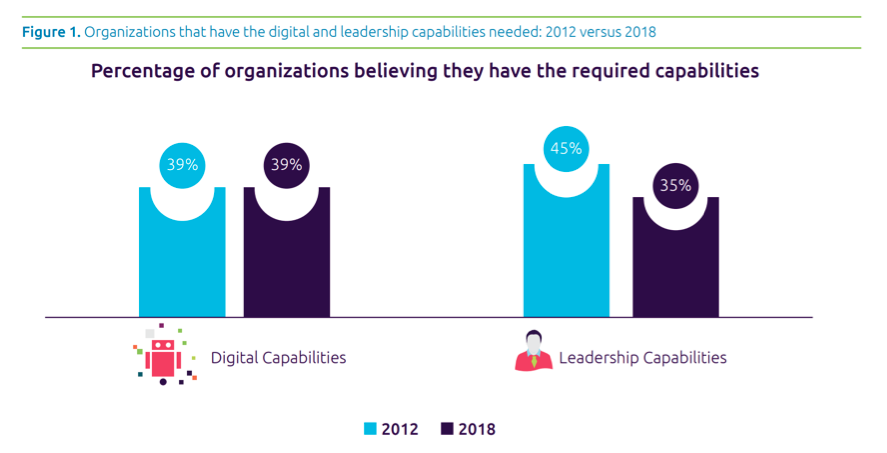In their recent report that was titled “Understanding digital mastery today”, Capgemini Digital Transformation Institute, showed some awful results that percentage of organizations who believe that they have the required leadership capabilities for digital transformations was decreased from 45% in 2012 to 35% in 2018, while digital capabilities remain the same on 39%.

Picture Source1: Understanding digital mastery today: Why companies are struggling with their digital transformations; Published by Capgemini Digital Transformation Institute, 2018.
FullReportLink: https://www.capgemini.com/wp-content/uploads/2018/07/Digital-Mastery-DTI-report_20180704_web.pdf
Capgemini Digital Transformation Institute list the leadership capabilities as those are necessary to create the conditions required to drive the transformation, which includes:
- The transformation vision,
- The governance model to lead the journey,
- The necessary relationships that information technology and business need to produce results and engage employees in the journey.
- Use technology to change,
- Interacts with customers,
- Operates internal processes,
- Defines its business model.
The report concluded that “despite six years after our original research, we find it is just as hard today as it was in 2012 to make digital transformations a success. While we see progress on customer experience, organizations have not kept pace on building the necessary capabilities in operations, IT-business relationships, vision, engagement, and governance”1.
In my opinion, one major reason for these findings is that leaders still need to recognize the fundamental difference between change and transformation, before they can lead their companies on a journey of legitimate digital transformation.
Most organizations are actually doing ‘change’ that is required to maintain and modernize an organization while being lulled into a false sense of transformation. Too many companies are changing through siloed digital projects and initiatives that are not sufficient to produce a strategic transformation while building the required digital and leadership capabilities.
The report continued “Today, many organizations might face the realities of the complexities of their journeys and realize just how challenging successfully transforming can be. Organizations have not moved forward fast enough”1.
This is showing clearly that most firms are not taking full advantage of digital transformation. Digital technologies are so affordable, but organizations are not successful in adopting digital transformation because their leaders most probably don’t know how to undertake digital business transformation even they were doing great operations and change management.
The Capgemini report also believed that “organizations might have been overly optimistic in 2012 and have now realized the magnitude of the challenge, along with the rising expectations of markets, employees, and customers put significant pressure on organizations”1.
In my opinion, many firms immersed in change initiatives are under the illusion of transformation. Leaders should ask the right questions about how and what to innovate and transform. They also should be fully aware that transformation is about creating a new future, without the constraints of the past. Some companies informing their stakeholders that they are transforming their business using digital when in fact they are only undergoing change by improving the past.
This is aligned with the additional findings in the Capgemini report that mentioned that in “Our 2018 research also revealed that talent and culture represent a major challenge that stands in the way of success, and organizations are often failing to ensure their employees feel part of the journey. A renewed focus on the key dimensions for success in digital transformation, such as operations and governance and, talent and culture, will help organizations revitalize their digital transformations. If organizations do not re-focus, they might continue to lag behind”1.
There are dangerous downsides for firms that fall under the illusion of transformation, that will never go away until leaders recognize the difference between change and transformation, and act accordingly. Organizations and leaders need to step out of their own comfort zone into the transformation zone to avoid the risk of becoming obsolete in an ever-changing and competitive world. Leaders need to remove any illusion and move away from making changes to their existing business, comfortable under the transformation illusion while neglecting the need to truly transform.
Original Report:
Understanding digital mastery today: Why companies are struggling with their digital transformations; Published by Capgemini Digital Transformation Institute, 2018.
FullReportLink: https://www.capgemini.com/wp-content/uploads/2018/07/Digital-Mastery-DTI-report_20180704_web.pdf
Article by channel:
Everything you need to know about Digital Transformation
The best articles, news and events direct to your inbox
Read more articles tagged: Featured, Leadership, Organisational Design







